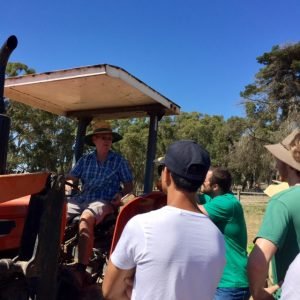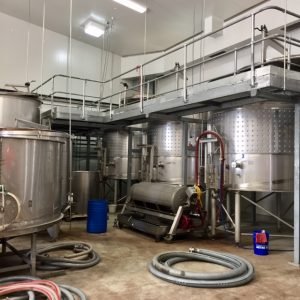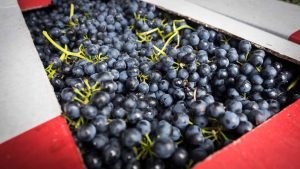So it turns out that the wine making business is a very dangerous game. Week 3 has been all about occupational health and safety in the vineyard and winery, centred on staying alive. Why do all these courses begin with a list of all the ways you could die? Well they do say that it is good to get out of your comfort zone…!
Top three things I have learnt this week:
1. How to drive a tractor

Tractor 101 with Steve
I must admit, ever since I found out that you would be taught how to drive a tractor on this course I have been excited. Despite not being a ‘natural’ driver (there was a point when I though I’d never get my car licence), I do rather like it. This week the day came and it was accompanied with a rather large bale of nerves.
As on a few occasions this week, the first half of the day was spent on theory. Mostly the theory surrounding just how dangerous these whopping machines are. A few chilling statistics were ploughed into us, and in my case, a great deal of fear cultivated. Luckily it seems that my age group is not amongst the most at risk. Apparently it is the over 60’s (often taught by their fathers at a young age), that fall foul of their trusty tractors. No OH&S back then you see. Our instructor Steve was in that category and recounted many a haphazard tale of disaster.

Tearing up the paddock on my first trip out
Along with the more obvious injuries like lacerations, it seems that the most common way to die with tractors is by rolling them over. It is also surprisingly easy to run yourself over.
In the end, with all due respect paid to these amazing machines, we stayed alive. The two we played with were surprisingly easy to operate and great fun. After lubricating all of the joints we were set a number of challenges including reversing and moving hay bales. Three weeks to go before we are fully qualified tractor masters, what will next week entail?
2. Staying alive in the winery

Red wine fermenters at Melbourne Poly
After surviving Tractor 101, it was time to scour the winery for potential dangers. Each of the enormous shiny metal machines were introduced to us in turn as we were asked to appraise them for dangers. Exposed jagged moving parts, rotating blades, high platforms, electrics and tripping hazards were plentiful. Gulp!
Too late to turn back now… We took it in turns to come up with ideas of how to minimise the risks and by the end the place did not seem quite so daunting.

OH&S Sorted
Just like tractors, everyone in the business knows of a fatality and everyone has a story. Carbon dioxide, produced during the fermentation of the grape must, accounts for many. As it is heavier than air, in poorly ventilated wineries it can sink forming a layer close to the ground. This is particularly dangerous if there are storage facilities below the level of the winery. In France they often have barrels stored in cellars under the winery which can become particularly treacherous.
3. Wine additives
Despite having been made naturally for thousands of years, wine in this day and age has a surprising number of additives. Most people are becoming aware of the addition of sulphur dioxide, especially if they are a little intolerant to it. However wines can be adjusted in many other ways too.
Decisions about additives are often formed very early after the berry sensory analysis (BSA) at the time of harvest. At this point the winemaker will get their first idea of any qualities that are lacking in this season’s fruit. For example, an earlier harvest may mean a higher acid content or sweeter berries may lack certain acidic or fruit characters. At this point plans can be put in place to compensate for these short falls.
One of the first considerations a winemaker faces is wild fermentation verses inoculation with a known yeast.
Acid in wine is very important, to balance the palate but also in controlling microbial spoilage. The Sulphur dioxide added to most wines, works in conjunction with the acid to prevent oxidation (leading to vinegar flavours) and spoilage. When acid levels are too low, tartaric acid is added, preferably before fermentation.
Regulations:
Every country has its own regulations with regards to additives in wine. In some countries chaptalization, the addition of sugar either for a second ferment in sparking wines or to raise the alcohol level is legal. Have you ever seen ‘contains egg’ on a wine label? That is because egg whites, along with a host of other chemicals are often used as a fining agent to clarify wines.
I could go on, but it is a mind blowing subject that, as a consumer, it is perhaps not best to dwell on. As Phil and I have just launched into making our own first vintage, these decisions are both important and vital.
Onward…

Box of grapes from Shiraz Republic
The grapes have literally started pouring into wineries all over Victoria this week and vintage 2017 is in full swing. We are beginning to see more action in the winery at uni and we are all looking forward to getting stuck in. Friday saw the second post-lecture wine gathering at The City Wine Shop, and I am already really fond of my course mates. I wonder where this course will take us all.
At home, our grapes arrived and we spent hours on Sunday night getting them ready for fermentation. A diary of our progress for Class to Glass ‘Teacher’s Pet’ Heathcote Shiraz 2017 will be posted from later this week.
On top of that I had the pleasure of visiting Foxey’s Hangout on the Mornington Peninsular at the weekend. Reviews coming soon.
Next week I do more things with my tractor, get stuck into some chemistry lab work, and learn more abut making wine. We will be pressing our fermented wine for Noisy Ritual too. Watch this space…
Thank you for reading.

